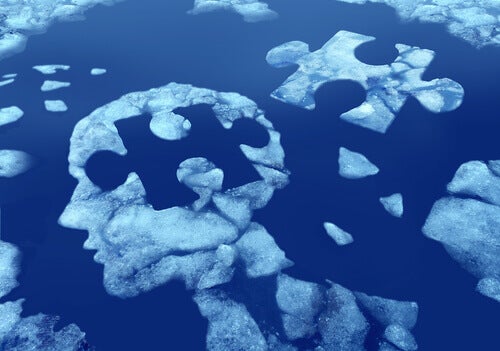The Economic Model of Psychoanalysis

Throughout the years, many people have studied personality, a variable which greatly influences behavior. Sigmund Freud, the father of psychoanalysis, approached it from different perspectives. In this article, we’ll be talking about one of them: the economic model of psychoanalysis.
Have you ever heard of libido, psychic energy, and drive? Well, these concepts are quite known, so much so that you might even use them sometimes without knowing their true definition or origin. Freud took them into account when establishing his economic theory of personality.
Continue reading this article to further explore this psychoanalysis model. It’ll definitely help you learn about another perspective of human personality. Additionally, you’ll see what concepts are related to this model, how energy works in our psyche, and the other models that make up the Freudian personality theory.
What’s the economic model of psychoanalysis?
It’s related to the study of personality from a Freudian perspective. It deals with the way energy works in our psyche. It evolved thanks to the scientific and philosophical spirit of the father of psychoanalysis.
Sigmund Freud believed that our psychic processes were related to the circulation and distribution of energy. According to this model, the energy of our psychic apparatus is likely to increase, decrease, or be equivalent.
According to this theory, the psychic apparatus is responsible for the transformation of energy, discharge postponement, and the elaboration of experiences. Therefore, we could describe this perspective as all those charges, discharges, overcharges, and equivalences that are mobilized in our psychic apparatus.

Concepts associated with the economic model of psychoanalysis
- Psychic elaboration. The transformation of energy.
- Drive. The force that guides us to satisfy internal desires, which don’t have to be necessarily sexual.
- Cathexis. The ability we have to direct our drive towards an object or representation. In other words, this refers to discharges of psychic energy. According to Freud, the ego, which is the structure that seeks to satisfy needs through pleasure, is the origin of cathexis.
- Libido. It’s the foundation of the dynamic between the mind and psychosexual development. This energy goes beyond sexual energy. In fact, it comes directly from our drives and helps direct our behavior. Therefore, it can be related to everything that gives us pleasure; for example, eating.
These concepts of the economic model of psychoanalysis are widely known. However, Freud was eager to learn more about the drives, so he ended up dividing them in two:
- Life drive. These are the impulses that motivate individuals not to give up pleasure in favor of survival and well-being.
- Death drive. This refers to the tendency toward self-destruction. However, it can be quite assertive if it’s well-managed.
Now, this model was based on the theories that Freud developed from 1914 to 1920 approximately. You can find more information in his books Beyond the Pleasure Principle and On Narcissism: An Introduction.

Other models
Moreover, to establish his theory of personality, Freud formulated several models, also known as topics. One of them is the economic one, which we’ve already expanded on. Here are the others:
- Topographical. It refers to a perspective where we can find different levels of consciousness. The unconscious, the preconscious, and the conscious. Many know this as the iceberg model since it uses an iceberg as an example of how deep consciousness can be.
- Psychodynamic. This model has to do with the impulses that seek gratification and those that go after inhibition through defense mechanisms.
- Genetic. This theory establishes that our psychosexual development is possible thanks to the search for satisfaction in the erogenous zones. There are different stages: oral, anal, phallic, latent, and genital.
- Structural model. It proposes that our mind is separated by different instances and that each of them acts on one level. That way, it forms a personality structure.
The fact that there are divisions in the Freudian personality theory doesn’t mean that each topic acts separately. In fact, in psychoanalysis, all concepts complement each other.
In brief, the economic model of psychoanalysis played a great role in the conception of the flow of energy in the human mind and how different drives tend to satisfy our instincts whereas others don’t. Additionally, he studied the transformation of these energies in our inner world. These theories were and continue to be a revolutionary way to analyze the mind.
All cited sources were thoroughly reviewed by our team to ensure their quality, reliability, currency, and validity. The bibliography of this article was considered reliable and of academic or scientific accuracy.
- Freud, A. & Carcamo, C.E. (1961). El yo y los mecanismos de defensa (vol 3). Barcelona: Paidós. Vels, A. (1990). Los mecanismos de defensa bajo el punto de vista (vol 6). psicoanalítico. Agrupación de Grafoanalistas Consultivos de España. Lacan, J. (2010). Seminario 1. Los escritos técnicos de Freud. Balint, 2, 6-54.
- Freud, S. (1973). Introducción al narcisismo y otros ensayos. Madrid: Alianza.
- Freud, S. (1976/1920). Más allá del principio del placer. Obras completas. Buenos Aires: Amorrortu.
- Freud, S. (2012). Tres ensayos sobre una teoría sexual. Buenos Aires: Alianza editorial.
- Freud, S. (1923/2016). El yo y el Ello. Madrid: Amorrortu.
- Freud, S. (2013). La interpretación de los sueños (Vol.267). Ediciones Akal.
This text is provided for informational purposes only and does not replace consultation with a professional. If in doubt, consult your specialist.








